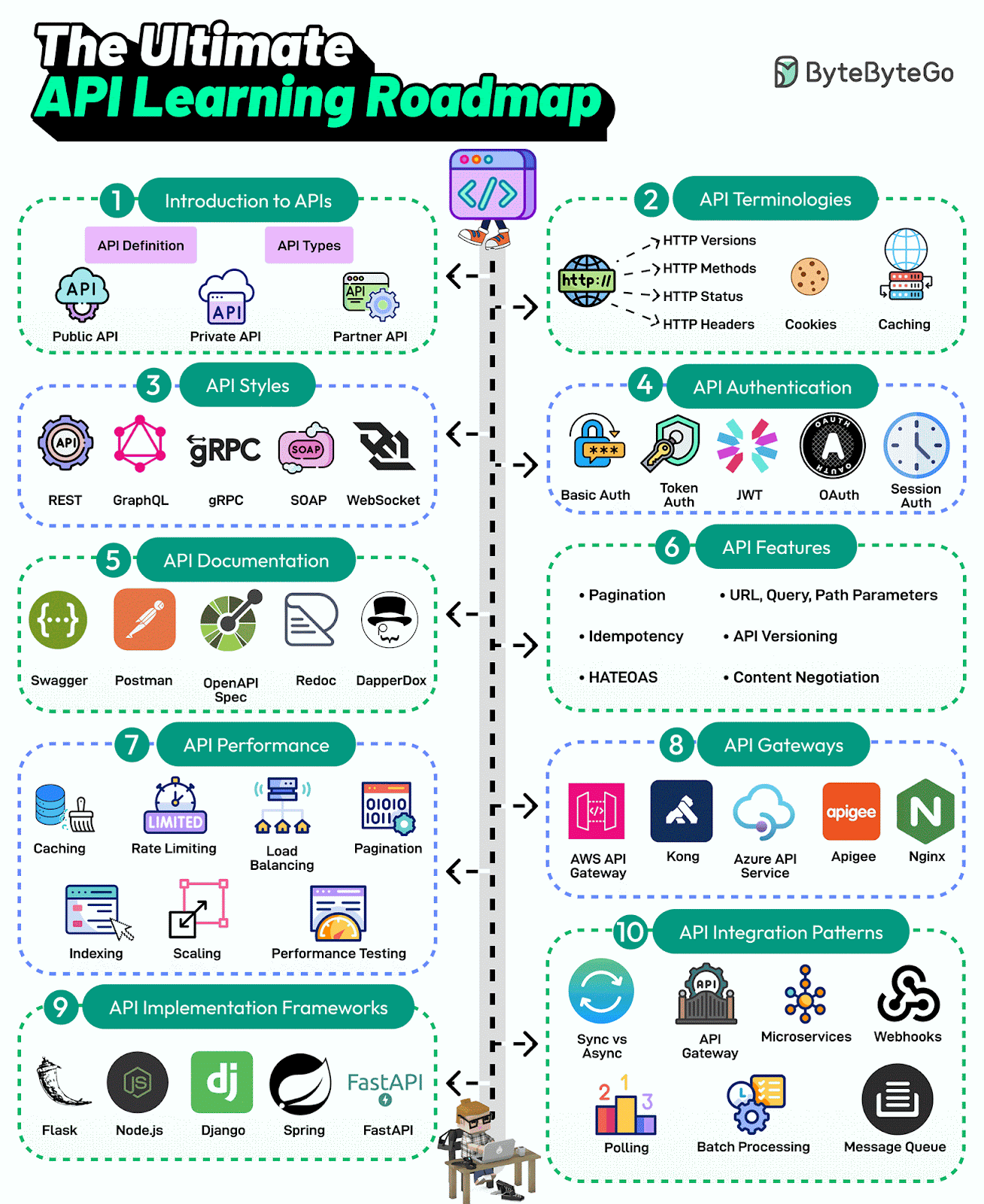
 What is API Architecture?
What is API Architecture?



- A banking system uses API architecture to allow different apps (mobile banking, ATMs, web banking) to securely access user account data.
- An e-commerce platform uses API architecture to connect the front-end website, inventory management system, and payment gateways.
 How API Architecture Helps?
How API Architecture Helps?
















 List of API Architecture Styles
List of API Architecture Styles
Different API architectures define how APIs are structured, interact, and communicate with clients. Below are the major API architecture styles:
 REST (Representational State Transfer)
REST (Representational State Transfer)

- Follows stateless HTTP-based communication using standard HTTP methods (
GET,POST,PUT,DELETE). - Uses JSON or XML for data exchange.

- Web & mobile applications
- Cloud services (AWS, Google Cloud APIs)
- Microservices architecture

- GitHub REST API, Twitter API, Google Maps API







 SOAP (Simple Object Access Protocol)
SOAP (Simple Object Access Protocol)

- Uses XML-based messaging with strict standards (WSDL, UDDI).
- Supports stateful and stateless communication.
- More complex than REST but highly secure & reliable.

- Enterprise applications (banking, insurance, healthcare)
- Financial transactions & security-sensitive APIs

- PayPal API, Banking APIs, Government Data APIs







 GraphQL
GraphQL

- Clients specify exactly what data they need, preventing over-fetching & under-fetching.
- Uses a single endpoint for all queries.

- Applications needing dynamic and complex data fetching
- Microservices & real-time apps
- Frontend-heavy applications (React, Angular, Vue.js)

- GitHub GraphQL API, Shopify API, Facebook API







 gRPC (Google Remote Procedure Call)
gRPC (Google Remote Procedure Call)

- Uses Protocol Buffers (Protobuf) instead of JSON, making it faster & efficient.
- Supports bidirectional streaming (real-time communication).

- High-performance, low-latency applications
- Microservices & distributed systems
- IoT & AI/ML applications

- Kubernetes API, Netflix API, Google Cloud APIs







 WebSockets API
WebSockets API

- Provides persistent two-way communication between client & server.
- Used for real-time applications where instant updates are needed.

- Live chat applications (WhatsApp, Slack, Discord)
- Stock market, sports updates
- Multiplayer gaming

- Binance API (crypto trading WebSockets)
- Slack WebSockets API





 RESTful Webhooks
RESTful Webhooks

- Allows event-driven architecture where APIs notify clients when events occur.
- Instead of polling, webhooks push updates automatically.

- Payment confirmations (PayPal, Stripe Webhooks)
- CI/CD pipeline triggers (GitHub Webhooks)
- Order & shipment updates

- Stripe Webhooks, GitHub Webhooks, Slack Incoming Webhooks






 RPC (Remote Procedure Call)
RPC (Remote Procedure Call)

- Allows direct function calls between applications over a network.
- Older APIs like XML-RPC, JSON-RPC use this architecture.

- Legacy systems & remote function execution
- Performance-sensitive microservices

- Ethereum JSON-RPC API, Amazon XML-RPC API






 Final Summary: Which API Architecture Should You Choose?
Final Summary: Which API Architecture Should You Choose?
| Use Case | Best API Architecture |
|---|---|
| Web & Mobile Applications | REST, GraphQL |
| Enterprise & Banking Apps | SOAP |
| Microservices Communication | gRPC, GraphQL |
| Real-Time Streaming (Chat, IoT, Stocks, Sports) | WebSockets, gRPC |
| Event-Driven APIs (Payments, CI/CD, Notifications) | Webhooks |
| Legacy System Integration | RPC (XML-RPC, JSON-RPC) |

- Use REST for general-purpose APIs.
- Use GraphQL for frontend-heavy applications.
- Use gRPC for microservices & real-time high-performance needs.
- Use WebSockets for live updates & messaging.
I’m a DevOps/SRE/DevSecOps/Cloud Expert passionate about sharing knowledge and experiences. I am working at Cotocus. I blog tech insights at DevOps School, travel stories at Holiday Landmark, stock market tips at Stocks Mantra, health and fitness guidance at My Medic Plus, product reviews at I reviewed , and SEO strategies at Wizbrand.
Please find my social handles as below;
Rajesh Kumar Personal Website
Rajesh Kumar at YOUTUBE
Rajesh Kumar at INSTAGRAM
Rajesh Kumar at X
Rajesh Kumar at FACEBOOK
Rajesh Kumar at LINKEDIN
Rajesh Kumar at PINTEREST
Rajesh Kumar at QUORA
Rajesh Kumar at WIZBRAND

 Starting: 1st of Every Month
Starting: 1st of Every Month  +91 8409492687
+91 8409492687  Contact@DevOpsSchool.com
Contact@DevOpsSchool.com
